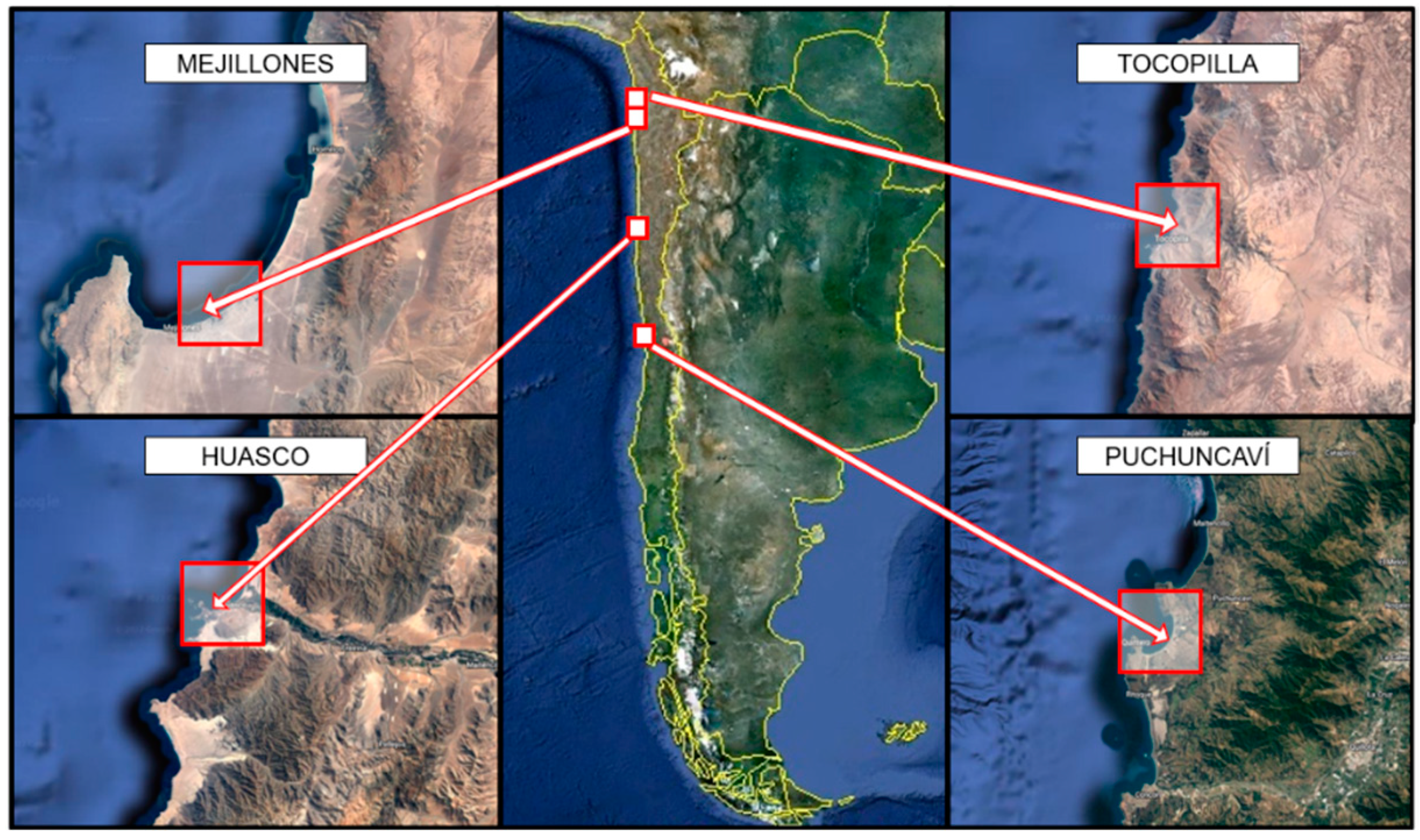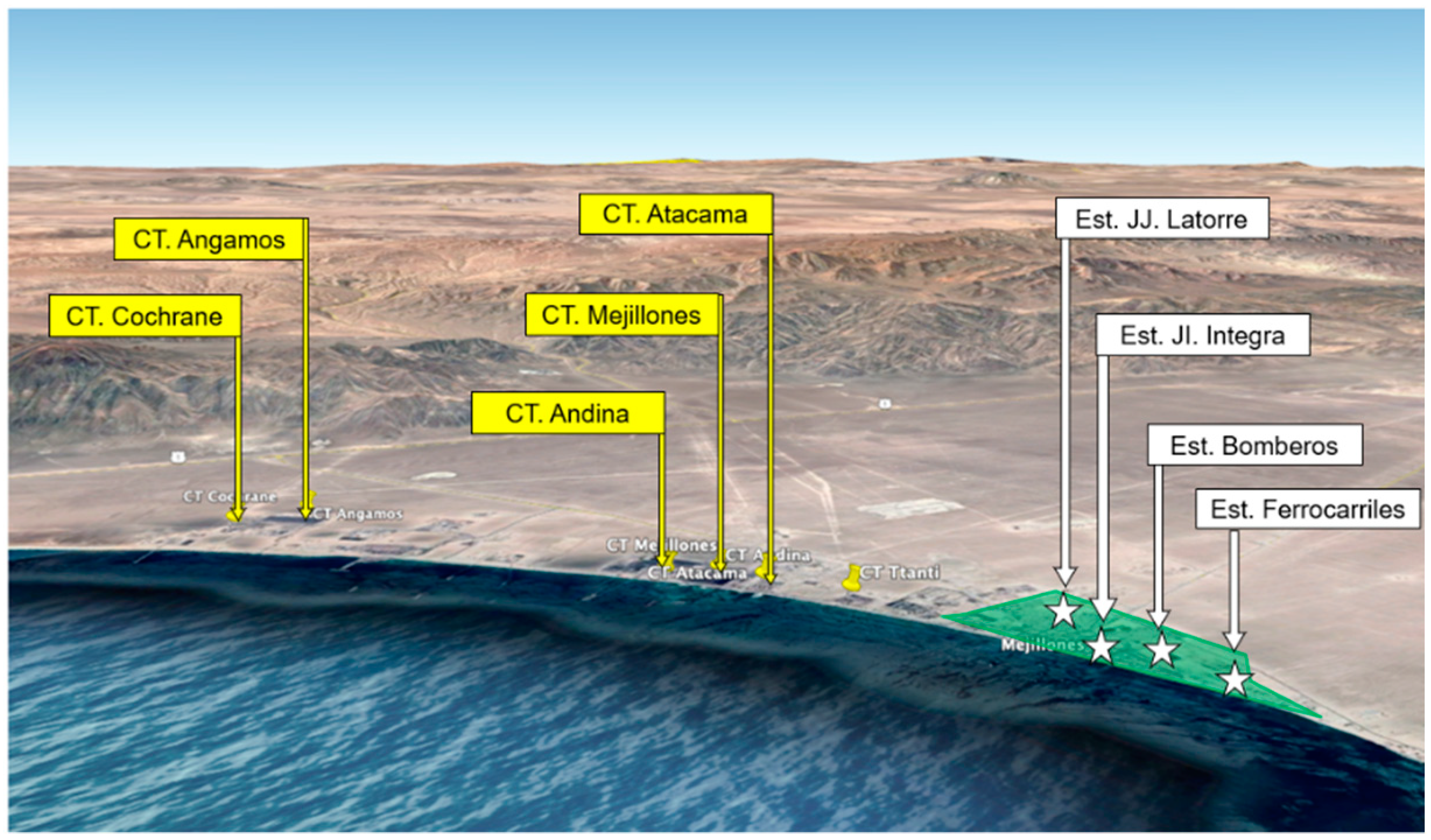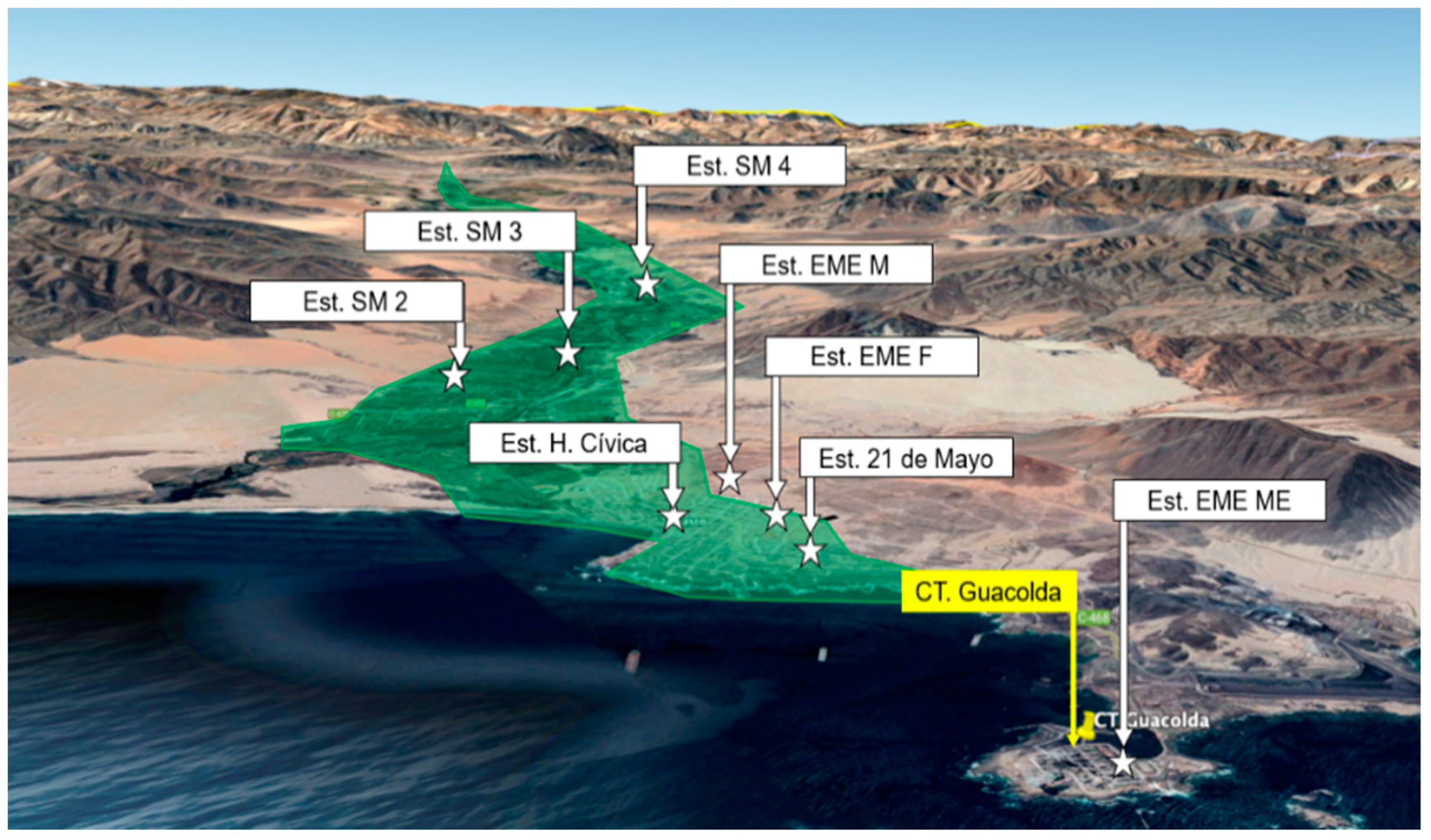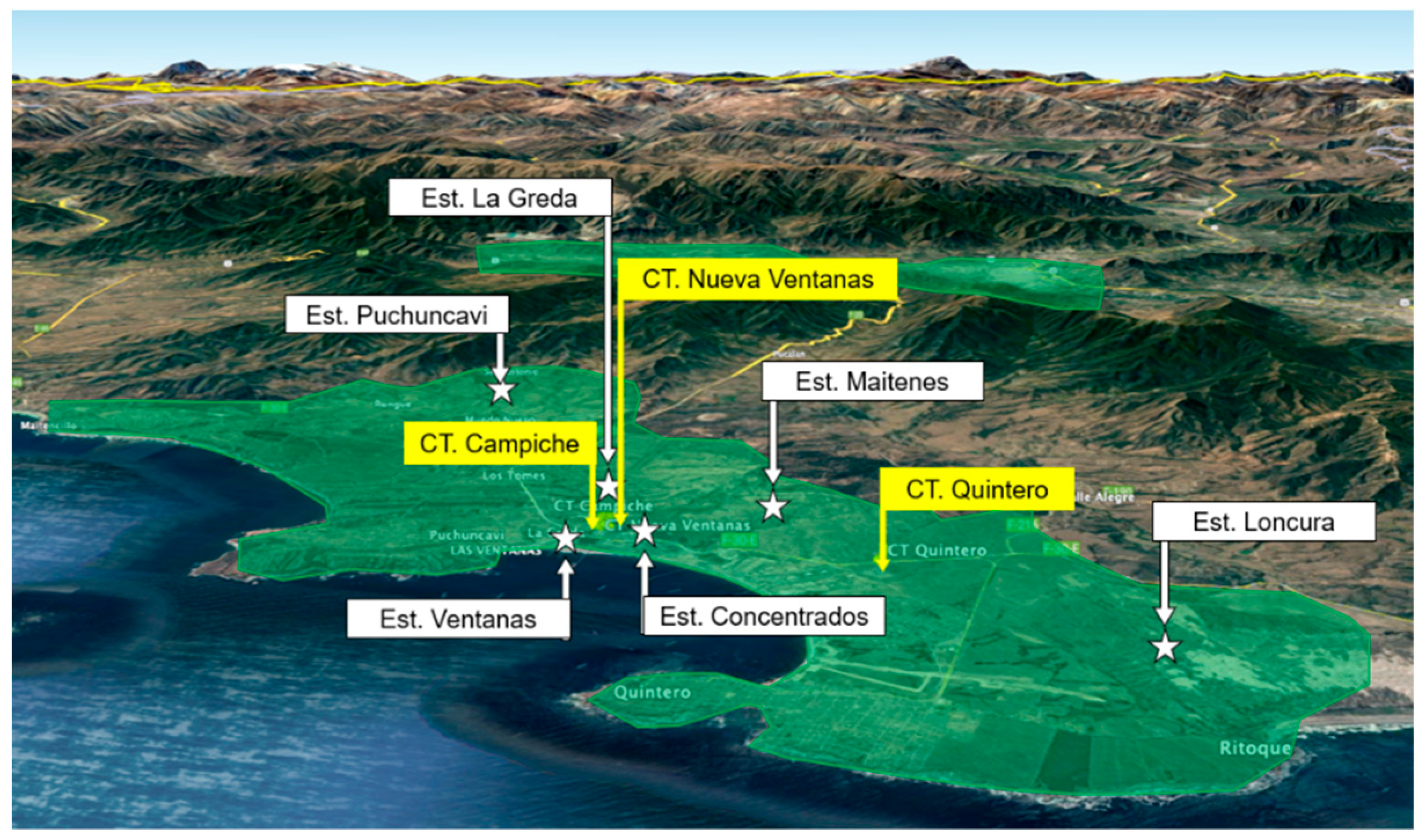Evaluation of Atmospheric Environmental Regulations: The Case of Thermoelectric Power Plants
Abstract
1. Introduction
1.1. Impact and Environmental Regulation
- Area of influence: The geographic area or space, whose attributes, namely natural or sociocultural elements, must be considered to define if the project or activity generates or presents any of the effects, characteristics, or circumstances of article 11 of Law 19.300, or to justify the non-existence of effects, characteristics, or circumstances;
- Emission: Release or transmission to the environment of any pollutant by a project or activity;
- Environmental impact: Alteration of the environment, caused directly or indirectly by a project or activity in an area;
- Baseline: Detailed description of the elements within the area of influence in which the effects or impacts of project implementation will be generated.
1.2. Power Generation and Atmospheric Emissions
- (i)
- It presents for the first time the crossing of information between the quality of records documented in the EIS and EIA, and the representativeness of air quality monitoring stations.
- (ii)
- It highlights the shortcomings and loopholes found in the current air quality regulations regarding the representativeness of atmospheric records.
- (iii)
- It shows the importance of the location of air quality monitoring stations in the representativeness of their records.
- (iv)
- It reveals Chile’s lack of awareness regarding the emission of atmospheric pollutants and, therefore, their consequences for health.
2. Materials and Methods
3. Results
3.1. Environmental Regulations
- D.S. No. 38/2011, Noise Standard;
- D.S. No. 43/2013, Light Pollution Standard;
- D.S. No. 28/2013, Foundry Standard;
- D.S. No. 13/2011, Standard for Thermoelectric Power Plants;
- D.S. No. 37/2013, TRS Compound Standard;
- D.S. No. 29/2013, Establishes Emission Standard for incineration, co-incineration and co-processing and repeals Decree No. 45, of 2007, of the Ministry General Secretariat of the Presidency.
3.2. Thermal Emitting Complexes
3.3. Station Registration
4. Discussion
5. Conclusions
Author Contributions
Funding
Institutional Review Board Statement
Informed Consent Statement
Data Availability Statement
Conflicts of Interest
References
- Reporte Energético Financiero Volume 10. 2019. Available online: https://www.cne.cl/wp-content/uploads/2019/10/RT_Financiero_v201910.pdf (accessed on 18 October 2022).
- Yuan, X.; Zhang, M.; Wang, O.; Wang, Y.; Zuo, J. Evolution analysis of environmental standards: Effectiveness on air pollutant emissions reduction. J. Clean. Prod. 2017, 149, 511–520. [Google Scholar] [CrossRef]
- Manisalidis, I.; Stavropoulou, E.; Stavropoulos, A.; Bezirtzoglou, E. Environmental and Health Impacts of Air Pol-lution: A Review. Front. Public Health 2020, 8, 14. [Google Scholar] [CrossRef] [PubMed]
- Eze, I.C.; Schaffner, E.; Fischer, E.; Schikowski, T.; Adam, M.; Imboden, M.; Tsai, M.; Carballo, D.; von Eckardstein, A.; Künzli, N.; et al. Long-term air pollution exposure and diabetes in a population-based Swiss cohort. Environ. Int. 2014, 70, 95–105. [Google Scholar] [CrossRef]
- Ashfaq, A.; Sharma, P. Environmental effects of air pollution and application of engineered methods to combat the problem. J. Ind. Pollut. Control. 2012, 29, 25–28. [Google Scholar]
- Varotsos, C.; Alexandris, D.; Chronopoulos, G.; Tzanis, C. Aircraft observations of the solar ultraviolet irradiance throughout the troposphere. J. Geophys. Res. Atmos. 2001, 106, 14843–14854. [Google Scholar] [CrossRef]
- Varotsos, C.A.; Efstathiou, M.N.; Kondratyev, K.Y. Longterm variation in surface ozone and its precursors in Athens, Greece-A forecasting tool. Environ. Sci. Pollut. Res. 2003, 10, 19–23. [Google Scholar]
- Varotsos, C.; Ondov, J.; Efstathiou, M. Scaling properties of air pollution in Athens, Greece and Baltimore, Maryland. Atmos. Environ. 2005, 39, 4041–4047. [Google Scholar] [CrossRef]
- Varotsos, C.; Tzanis, C.; Cracknell, A. The enhanced deterioration of the cultural heritage monuments due to air pollution. Environ. Sci. Pollut. Res. 2009, 16, 590–592. [Google Scholar] [CrossRef] [PubMed]
- Mohammed, A.M.; Saleh, I.A.; El-Hemaly, S.A. Impact of air pollutants on some building materials in Cairo atmosphere. Mater. Sci. Eng. Int. J. 2021, 5, 49–58. [Google Scholar] [CrossRef]
- Galleguillos, C. Efecto De Las Termoeléctricas Sobre La Incidencia De Enfermedades Cardiovasculares En Chile 2001–2010: Un Enfoque Bayesiano De Estimación. Master’s Thesis, Facultad de Medicina Universidad de Chile, Santiago de Chile, Chile, 2017. [Google Scholar]
- Ley 19300-Aprueba Ley Sobre Bases Generales Del Medio Ambiente. Available online: https://www.bcn.cl/leychile/navegar?idNorma=30667&idParte=9705635&idVersion=2021-08-13 (accessed on 18 October 2022).
- Del Fávero, G. Ley Sobre Bases Generales del Medio Ambiente. In Medio Ambiente en Desarrollo; Centro de Estudios Públios: Santiago de Chile, Chile, 1994; pp. 1–46. [Google Scholar]
- Nuñez, R. La gestión pública en la Región Metropolitana de Santiago de Chile: Aproximación a través del caso Ambiental. In Repositorio Digital Comisión Económica Para América Latina y el Caribe; Instituto Latinoamericano y del Caribe de Planificación Económica y Social (ILPES): Santiago de Chile, Chile, 2003; Num 39; pp. 1–39. [Google Scholar]
- Bergrami, K.; Perez, C. Fiscalización y cumplimiento ambiental en Chile: Principales avances, desafíos y tareas pendientes. EURE 2015, 14, 267–277. [Google Scholar] [CrossRef]
- Ley 20417-Crea El Ministerio, El Servicio De Evaluación Ambiental Y La Superintendencia Del Medio Ambiente. Available online: https://www.bcn.cl/leychile/navegar?idNorma=1010459 (accessed on 18 October 2022).
- Varotsos, C.; Ondov, J.; Tzanis, C.; Öztürk, F.; Nelson, M.; Ke, H.; Christodoulakis, J. An observational study of the atmospheric ultra-fine particle dynamics. Atmos. Environ. 2012, 59, 312–319. [Google Scholar] [CrossRef]
- Guttikunda, S.K.; Goel, R.; Pant, P. Nature of air pollution, emission sources, and management in the Indian cities. Atmos. Environ. 2012, 95, 501–510. [Google Scholar] [CrossRef]
- Decreto 13 Establece Norma De Emisión Para Centrales Termoeléctricas. Available online: https://www.bcn.cl/leychile/navegar?idNorma=1026808 (accessed on 18 October 2022).
- Urqueta, J. Estimación De Emisiones Contaminantes Generadas Por Termoeléctricas Y Fundiciones En Chile. In Titulo Ingeniero Civil Mecánico Mención Energía; Departamento de Ingeniería Mecánica Universidad Técnica Federico Santa María: Santiago de Chile, Chile, 2018. [Google Scholar]
- Decreto 40-Aprueba Reglamento Del Sistema De Evaluación De Impacto Ambiental. Available online: https://www.bcn.cl/leychile/navegar?i=1053563&f=2013-12-24 (accessed on 18 October 2022).
- Guía Para la Descripción del Área de Influencia Calidad Del Aire En El Área De Influencia De Proyectos Que Ingresan Al Seia. Available online: https://www.sea.gob.cl/sites/default/files/imce/archivos/2016/01/20/guia_calidad_del_aire.pdf (accessed on 18 October 2022).
- Loyola, E. Evaluación De Escenarios De Mitigación Del Cambio Climático En Chile Con Respecto Al Objetivo Establecido En El Acuerdo De París. In Titulo Ingeniero Civil; Facultad de Ciencias Físicas y Matemáticas Universidad de Chile: Santiago de Chile, Chile, 2019. [Google Scholar]
- Hamid, M.; Abdulameer, D.; Mohd, M.F.; Mohd, S.B.; Haji, M.; Bashir, M.; Mohamad, M. A review on thermoelectric renewable energy: Principle parameters that affect their performance. Renew. Sustain. Energy Rev. 2014, 30, 337–355. [Google Scholar] [CrossRef]
- Chelani, A. Long-memory property in air pollutant concentrations. Atmos. Res. 2016, 171, 1–4. [Google Scholar] [CrossRef]
- Reporte Annual 2020 Generadoras de Chile. Available online: http://generadoras.cl/documentos/reportes-anuales/reporte-anual-2020 (accessed on 18 October 2022).
- Chauan, J. Zonas de Sacrificio: Experiencias Cotidianas en Territories Contaminados, la Bahía de Quintero-Puchuncaví; Titulo Antropologo Social Universidad de Chile: Santiago de Chile, Chile, 2019. [Google Scholar]
- Villasana, P.; Dorner, A.; Estay, J.; Moreno, G.; Monteverde, A. Zonas de Sacrificio y Justicia Ambiental en Chile. Una Mirada Crítica desde los Objetivos de Desarrollo Sostenible 2030. HALAC—Historia Ambiental Latinoamericana y Caribeña 2020, 10, 342–365. [Google Scholar] [CrossRef]
- Hannun, R.; Abdul, A. Air Pollution Resulted from Coal, Oil and Gas Firing in Thermal Power Plants and Treatment: A Review. In Proceedings of the First International Scientific Conference on the Environment of Marshes and Water Surfaces, Al-Nasiriyah, Iraq, 17–18 November 2021. [Google Scholar]
- Guía Metodológica Para La Estimación De Emisiones Provenientes De Fuentes Puntuales. Available online: https://retc.mma.gob.cl/wp-content/uploads/2021/07/Guia-metodologica-para-la-estimacion-de-emisiones-provinientes-de-fuentes-puntuales.pdf (accessed on 18 October 2022).
- Decreto 12-Establece Norma Primaria De Calidad Ambiental Para Material Particulado Fino Respirable Mp 2,5. Available online: https://www.bcn.cl/leychile/navegar?idNorma=1025202 (accessed on 18 October 2022).
- Decreto 12-Establece Norma Primaria De Calidad Ambiental Para Material Particulado Respirable Mp10. Available online: https://www.bcn.cl/leychile/navegar?idNorma=1176988 (accessed on 18 October 2022).
- Decreto 104-Establece Norma Primaria De Calidad De Aire Para Dióxido De Azufre (So2). Available online: https://www.bcn.cl/leychile/navegar?idNorma=1131641&idParte=0 (accessed on 18 October 2022).
- Decreto 114-Establece Norma Primaria De Calidad De Aire Para Dioxido De Nitrogeno (No2). Available online: https://www.bcn.cl/leychile/navegar?idNorma=208185 (accessed on 18 October 2022).
- Decreto 115 Establece Norma Primaria De Calidad De Aire Para Monoxido De Carbono (Co). Available online: https://www.bcn.cl/leychile/navegar?idNorma=202437 (accessed on 18 October 2022).
- Decreto 136-Establece Norma De Calidad Primaria Para Plomo En El Aire. Available online: https://www.bcn.cl/leychile/navegar?idNorma=179878 (accessed on 18 October 2022).
- Decreto 112-Establece Norma Primaria De Calidad De Aire Para Ozono (O3). Available online: https://www.bcn.cl/leychile/navegar?i=208198&f=2003-03-06 (accessed on 18 October 2022).
- Decreto 22-Establece Norma De Calidad Secundaria De Aire Para Anhídrido Sulfuroso (So2). Available online: https://www.bcn.cl/leychile/navegar?idNorma=1012498&idParte=0 (accessed on 18 October 2022).
- Decreto 4 Exento-Establece Normas de Calidad del Aire Para Material Particulado Sedimentable en la Cuencia del Rio Huasco III Region. Available online: https://www.bcn.cl/leychile/navegar?i=95904&f=1992-05-26 (accessed on 18 October 2022).
- Zonas de Sacrificio en Chile: Quintero-Puchuncaví, Coronel, Mejillones, Tocopilla y Huasco Componente industrial y Salud de la Población. Available online: https://obtienearchivo.bcn.cl/obtienearchivo?id=repositorio/10221/33401/1/BCN_Zonas_de_sacrificio_en_Chile_2022_FINAL.pdf (accessed on 18 October 2022).
- Decreto 61 Aprueba Reglamento De Estaciones De Medición De Contaminantes Atmosféricos. Available online: https://www.bcn.cl/leychile/navegar?i=281728&f=2009-09-21 (accessed on 18 October 2022).
- Molina, F.; Cañas, E. Régimen Jurídico de las Estaciones de Monitoreo de Contaminantes Atmosféricos: Regulación, Responsabilidades y Órganos Competentes. Propuestas Para una Actualización Normative. Rev. De Derecho Ambiental. 2020, 14, 43–70. [Google Scholar] [CrossRef]
- Bustos, C. Aplicación de Modelos de Dispersión Atmosférica en la Evaluación de Impacto Ambiental: Análisis del Proceso. Master’s Thesis, Universidad de Chile, Santiago de Chile, Chile, 2004. [Google Scholar]
- Resolucion 744-Exenta Establece Criterios Para Calificar Estaciones De Monitoreo De Material Particulado Respirable (Mp10) Como De Representatividad Poblacional. Available online: https://www.bcn.cl/leychile/navegar?i=1105514 (accessed on 18 October 2022).
- Cabrera, J. Aplicación de un Modelo de Dispersión Atmosférica; Titulo de Ingeniero Civil Químico en Pontificia Universidad Católica de Valparaiso: Valparaíso, Chile, 2012. [Google Scholar]
- Jaime Illanes y Asociados Consultores. Technical Report “Estudio Impacto Ambiental Central Térmica Andino”; Antofagasta, Chile; 2006. Available online: https://seia.sea.gob.cl/elementosFisicos/enviados.php?id_documento=2128725803 (accessed on 4 February 2023).
- Arcadis Geotecnica. Technical Report “Estudio de Impacto Ambiental Central Termoeléctrica Cochrane”, Antofagasta, Chile; 2008. Available online: https://seia.sea.gob.cl/elementosFisicos/enviados.php?id_documento=2128725995 (accessed on 4 February 2023).
- Arcadis Geotecnica. Technical Report “Estudio de Impacto Ambiental Central Termoeléctrica Angamos”, Antofagasta, Chile; 2006. Available online: https://seia.sea.gob.cl/elementosFisicos/enviados.php?id_documento=3030998 (accessed on 4 February 2023).
- Guia Para el uso de Modelos de Calidad de Aire en el SEIA. Available online: https://www.sea.gob.cl/sites/default/files/migration_files/guias/Guia_uso_modelo_calidad_del_aire_seia.pdf (accessed on 18 October 2022).
- Gobler, C.J.; Baumann, H. Hypoxia and acidification in ocean ecosystems: Coupled dynamics and effects on marine life. Biol. Lett. 2016, 12, 20150976. [Google Scholar] [CrossRef] [PubMed]
- Figuerola, B.; Hancock, A.M.; Bax, N.; Cummings, V.J.; Downey, R.; Griffiths, H.J.; Smith, J.; Stark, J.S. A Review and Meta-Analysis of Potential Impacts of Ocean Acidification on Marine Calcifiers from the Southern Ocean. Front. Mar. Sci. 2021, 8, 584445. [Google Scholar] [CrossRef]
- Mendez, P. Algunas precisioens sobre el término anticipado del procesamiento de evaluación Ambiental. Rev. Derecho 2016, 29, 141–159. [Google Scholar]
- Perevochtchikova, M. La evaluación del impacto ambiental y la importancia de los indicadores ambientales. In Gestión y Política Pública; Centro de Investigación y Docencia Económica, Pedregal de Santa Teresa: Mexico City, Mexico, 2013; Volume 22, Number 2. [Google Scholar]
- Rioseco, G.; Mardones, M.; Jimene, J. Efecto Directo E Indirecto De La Dispersion De Las Emisiones Industriales Sobre La Regulacion Ambiental. Rev. De Análisis Económico 2015, 30, 79–96. [Google Scholar] [CrossRef]





| Pollutant | Period | Level | Concentration (µg/m3N) | Reference |
|---|---|---|---|---|
| PM 2.5 | 24 h | Alert | 80–109 | [31] |
| Pre-emergency | 110–169 | |||
| Emergency | 170 or + | |||
| PM10 | 24 h | Alert | 195–239 | [32] |
| Pre-emergency | 240–329 | |||
| Emergency | 330 or + | |||
| SO2 | 1 h | Alert | 500–649 | [33] |
| Pre-emergency | 650–949 | |||
| Emergency | 950 or + | |||
| NO2 | 1 h | Alert | 1130–2259 | [34] |
| Pre-emergency | 2260–2999 | |||
| Emergency | 3000 or + | |||
| CO | 8 h | Alert | 17–33 | [35] |
| Pre-emergency | 34–39 | |||
| Emergency | 40 or + | |||
| O3 | 1 h | Alert | 400–799 | [37] |
| Pre-emergency | 800–999 | |||
| Emergency | 1000 or + |
| Pollutant | Period | Concentration Northern Zone (µg/m3N) | Concentration Southern Zone (µg/m3N) | Reference |
|---|---|---|---|---|
| SO2 | Annual | 80 | 60 | Art 4 [38] |
| 24 h | 365 | 260 | Art 5 [38] | |
| 1 h | 1000 | 700 | Art 6 [38] |
| Year | Central | Project Name | Type | Commune | Latitude | Longitude |
|---|---|---|---|---|---|---|
| 1999 | Coloso | Central Termoeléctrica de Ciclo Combinado Coloso | EIA | Tocopilla | −23.77279 | −70.482385 |
| 1993 | Nueva Tocopilla | Central Termoeléctrica Nueva Tocopilla 1 | EIA | Tocopilla | −22.09617 | −70.210518 |
| 1993 | Nueva Tocopilla | Central Termoeléctrica Nueva Tocopilla 2 1 | EIA | Tocopilla | −22.09573 | −70.209923 |
| 1996 | Nueva Tocopilla | Sistema de Transmisión Central Termoeléctrica Nueva Tocopilla 1 | EIA | Tocopilla | −22.09625 | −70.211992 |
| 1999 | Nueva Tocopilla | Aumento de potencia de generación y uso de mezclas de petcoke y carbón central termoeléctrica nueva Tocopilla 1 | EIA | Tocopilla | −22.09774 | −70.213217 |
| 1998 | Tocopilla | Central Termoeléctrica de Ciclo Combinado Tocopilla 1 | EIA | Tocopilla | −22.09779 | −70.212732 |
| 1999 | Tocopilla | Uso de Mezclas de Carbón y Coque de Petróleo como Combustible Central Tocopilla (2° presentación) 1 | EIA | Tocopilla | −22.09625 | −70.211992 |
| 2007 | Tocopilla | Operación permanente con petróleo diésel en la Unidad 16 1 | EIS | Tocopilla | −22.09754 | −70.212488 |
| 2013 | Tocopilla | Uso de Cal Hidratada, Central Termoeléctrica Tocopilla para Cumplimiento de Norma de Emisión para Centrales Térmicas 1 | EIS | Tocopilla | −22.10077 | −70.213572 |
| 2006 | Andina | Central Térmica Andina1 | EIA | Mejillones | −23.08942 | −70.412632 |
| 2007 | Andina | Embarcadero, Uso de Biomasa y Depósito de Cenizas Central Térmica Andino 1 | EIS | Mejillones | −23.12666 | −70.30776 |
| 2006 | Angamos | Central Termoeléctrica Angamos 1 | EIA | Mejillones | −23.07049 | −70.365255 |
| 2008 | Angamos | Modificación del Punto de Toma y Descarga Central Termoeléctrica Angamos 1 | EIS | Mejillones | −23.05782 | −70.373805 |
| 1997 | Atacama | Central Térmica Atacama 1 | EIA | Mejillones | −23.08787 | −70.414243 |
| 2002 | Atacama | Inclusión de By Pass de Gases y un Sistema de Aeroenfriadores en los Equipos Accesorios de una de las Turbinas a Gas de la Central Térmica Atacama Comuna de Mejillones II Región 1 | EIS | Mejillones | −23.09159 | −70.417532 |
| 2007 | Atacama | Obras Complementarias Central Atacama 1 | EIS | Mejillones | −23.08788 | −70.414613 |
| 2008 | Cochrane | Central Termoeléctrica Cochrane | EIA | Mejillones | −23.07314 | −70.36746 |
| 1996 | Mejillones | Central Termoeléctrica Mejillones Unidad 2 1 | EIA | Mejillones | −23.08612 | −70.409343 |
| 1998 | Mejillones | Central Termoeléctrica Ciclo Combinado Mejillones CTM3 1 | EIA | Mejillones | −23.08613 | −70.408367 |
| 2001 | Mejillones | Uso de un Combustible Alternativo en las Unidades 1 y 2 de la Central térmica Mejillones 1 | EIA | Mejillones | −23.09015 | −70.41291 |
| 2009 | Mejillones | Infraestructura Energética Mejillones 1 | EIA | Mejillones | −23.08640 | −70.405139 |
| 2014 | Mejillones | Uso de Cal Hidratada, Central Térmica Mejillones para Cumplimiento de Norma de Emisión para Centrales Termoeléctricas 1 | EIS | Mejillones | −23.08877 | −70.412309 |
| 2015 | Mejillones | Actualización Infraestructura Energética Mejillones 1 | EIS | Mejillones | −23.08640 | −70.405139 |
| 2013 | Ttanti | Central Termoeléctrica Ttanti | EIA | Mejillones | −23.09290 | −70.424595 |
| 1994 | Guacolda | Central Termoeléctrica Guacolda y Vertedero 1 | EIA | Huasco | −28.46511 | −71.255619 |
| 1999 | Guacolda | Usos de Mezclas de Carbón y Petcoke en Central Termoeléctrica Guacolda 1 | EIA | Huasco | −28.46511 | −71.255619 |
| 2004 | Guacolda | Flexibilización de la Operación en la Central Termoeléctrica Guacolda 1 | EIS | Huasco | −28.46397 | −71.257178 |
| 2005 | Guacolda | Central Guacolda Unidad N°3 1 | EIA | Huasco | −28.46511 | −71.255619 |
| 2006 | Guacolda | Flexibilización Unidad N°3 1 | EIS | Huasco | −28.46475 | −71.256245 |
| 2007 | Guacolda | Incremento de Generación y Control de Emisiones del Complejo Generador Central Térmica Guacolda 1 | EIA | Huasco | −28.46511 | −71.255619 |
| 2006 | Guacolda | Ampliación de la capacidad de almacenamiento de combustibles sólidos en la Central Térmica Guacolda 1 | EIS | Huasco | −28.46511 | −71.255619 |
| 2009 | Guacolda | Unidad 5 Central Térmica Guacolda S.A. 1 | EIA | Huasco | −28.46511 | −71.255619 |
| 2016 | Guacolda | Eliminación del uso de petcoke en central Guacolda y Ajuste de la Capacidad de Generación Eléctrica 1 | EIS | Huasco | −28.46496 | −71.256566 |
| 2009 | Maitencillo | Central Termoeléctrica Maitencillo | EIS | Huasco | −28.50853 | −70.91914 |
| 2012 | Punta Alcalde | Central Termoeléctrica Punta Alcalde | EIA | Huasco | −28.57843 | −71.2874 |
| 2012 | Campiche | Central Termoeléctrica Campiche 1 | EIA | Puchuncavi | −32.75278 | −71.478981 |
| 2005 | Nueva Ventanas | Central Termoeléctrica Nueva Ventanas (LFC) 1 | EIA | Puchuncavi | −32.7517 | −71.479378 |
| 2006 | Nueva Ventanas | Cambio de Combustible de la Central Termoeléctrica Nueva Ventanas 1 | EIS | Puchuncavi | −32.75029 | −71.483487 |
| 2007 | Nueva Ventanas | Ajuste de la disposición general de las instalaciones de la central nueva ventanas 1 | EIS | Puchuncavi | −32.75265 | −71.480044 |
| Commune | Station | E | N | PM10 | PM2.5 | SO2 | NO2 | NOx | NO | CO | O3 | CH4 | HCNM | HTC |
|---|---|---|---|---|---|---|---|---|---|---|---|---|---|---|
| Mejillones | Jardín Infantil Integra | 352,064 | 7,444,407 | x | x | x | x | |||||||
| Mejillones | Juan Jose Latorre | 352,346 | 7,444,100 | x | x | x | x | x | x | |||||
| Mejillones | Compañía de Bomberos | 351,468 | 7,444,654 | x | x | x | x | x | x | |||||
| Mejillones | Ferrocarriles | 350,205 | 7,444,908 | x | x | x | x | x | x | x | x | |||
| Tocopilla | Bomberos | 375,319 | 7,554,741 | x | ||||||||||
| Tocopilla | Gobernación | 376,284 | 7,556,725 | x | x | |||||||||
| Tocopilla | Super Site | 377,404 | 7,557,193 | x | x | x | x | x | x | x | x | |||
| Tocopilla | Tres Marias | 377,485 | 7,560,029 | x | x | |||||||||
| Tocopilla | Escuela E10 | 377,352 | 7,557,219 | x | x | x | x | x | x | x | x | |||
| Tocopilla | Centro | 376,516 | 7,556,334 | x | ||||||||||
| Tocopilla | Escuela E12 | 376,731 | 7,556,849 | x | x | |||||||||
| Tocopilla | Escuela Gabriela Mistral | 376,518 | 7,556,323 | x | ||||||||||
| Tocopilla | Sur | 374,794 | 7,554,836 | x | x | |||||||||
| Huasco | Huasco Sivica | 282,682 | 6,848,727 | x | ||||||||||
| Huasco | 21 de Mayo | 281,938 | 6,848,939 | x | x | |||||||||
| Huasco | EME F | 282,486 | 6,849,125 | x | x | x | x | x | x | x | ||||
| Huasco | EME M | 282,763 | 6,848,691 | x | x | x | x | x | ||||||
| Huasco | EME ME | 279,008 | 6,849,199 | x | ||||||||||
| Huasco | Huasco II | 281,581 | 6,849,067 | x | x | x | x | |||||||
| Huasco | SM1 | 279,357 | 6,845,277 | x | ||||||||||
| Huasco | SM2 | 286,412 | 6,849,717 | x | ||||||||||
| Huasco | SM3 | 286,750 | 6,848,592 | x | ||||||||||
| Huasco | SM4 | 287,841 | 6,847,562 | x | ||||||||||
| Huasco | SM5 | 289,916 | 6,847,254 | x | ||||||||||
| Puchuncavi | Puchuncaví | 274,379 | 6,377,331 | x | x | x | x | x | x | x | ||||
| Puchuncavi | Campiche | 270,343 | 6,375,300 | x | x | x | x | x | x | x | x | x | ||
| Puchuncavi | La Greda | 268,185 | 6,373,910 | x | x | x | x | x | x | x | ||||
| Puchuncavi | Los Maitenes | 270,073 | 6,372,171 | x | x | x | x | x | x | x | x | x | x | x |
| Puchuncavi | Ventanas | 267,547 | 6,374,609 | x | x | x | x | x | x | x | x | x | x | |
| Puchuncavi | Concentrados | 267,640 | 6,373,585 | x | x | x | x | x | x | x | x |
Disclaimer/Publisher’s Note: The statements, opinions and data contained in all publications are solely those of the individual author(s) and contributor(s) and not of MDPI and/or the editor(s). MDPI and/or the editor(s) disclaim responsibility for any injury to people or property resulting from any ideas, methods, instructions or products referred to in the content. |
© 2023 by the authors. Licensee MDPI, Basel, Switzerland. This article is an open access article distributed under the terms and conditions of the Creative Commons Attribution (CC BY) license (https://creativecommons.org/licenses/by/4.0/).
Share and Cite
Concha, M.; Ruz, G.A. Evaluation of Atmospheric Environmental Regulations: The Case of Thermoelectric Power Plants. Atmosphere 2023, 14, 358. https://doi.org/10.3390/atmos14020358
Concha M, Ruz GA. Evaluation of Atmospheric Environmental Regulations: The Case of Thermoelectric Power Plants. Atmosphere. 2023; 14(2):358. https://doi.org/10.3390/atmos14020358
Chicago/Turabian StyleConcha, Mateo, and Gonzalo A. Ruz. 2023. "Evaluation of Atmospheric Environmental Regulations: The Case of Thermoelectric Power Plants" Atmosphere 14, no. 2: 358. https://doi.org/10.3390/atmos14020358
APA StyleConcha, M., & Ruz, G. A. (2023). Evaluation of Atmospheric Environmental Regulations: The Case of Thermoelectric Power Plants. Atmosphere, 14(2), 358. https://doi.org/10.3390/atmos14020358






